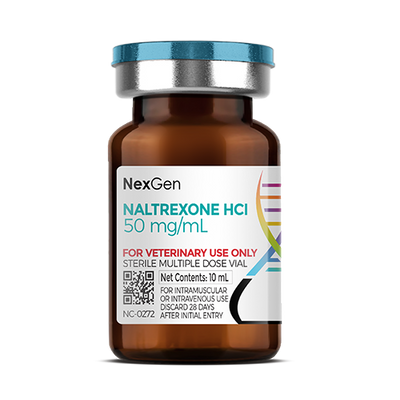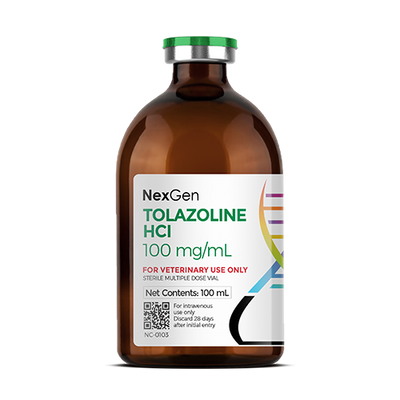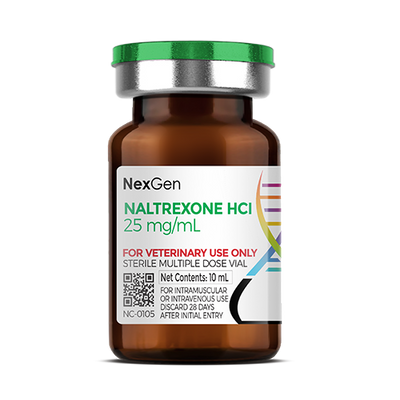
Naltrexone HCl 50 mg/mL, Injectable, (30mL)
Login for pricing
- Brand
- Mixlab
- SKU:
- NC-0527
- Product Type:
- Injectable
- Size:
- 30ml
- Administration:
- Intravenous
Opioids are a class of drugs that include natural derivatives (e.g., illicit drugs such as heroin), synthetic opioids such as fentanyl and prescription pain relievers such as oxycodone, hydrocodone, codeine and morphine. Powerful opiates are essential tools for capturing and handling wild and exotic animals.
Some characteristics of opioids include:
- The most potent drugs available for immobilization
- Specific antagonists readily available
- Reduced volume of drugs are typically required
- The only class of drugs practical for remote immobilization of large animals
- Potentially toxic to humans
Opioids provide rapid, long-lasting immobilization that can be completely reversed by specific opiate antagonists. The use of antagonists to reverse the effects of opioids is preferred over natural recovery in wild animals, as this avoids the release of compromised, potentially vulnerable animals back into their environments. Although some animals initially recover within minutes of receiving an antagonist, others can revert to a partially or completely narcotized state several hours later.1
Factors believed to predispose or contribute to renarcotization include rapid metabolism of antagonists, deposition of opiates in subcutaneous tissues or fascial planes during injection, entero-hepatic shunting of opiates or metabolites, extremely high opiate doses and variable individual or species sensitivities to opiates.2 Renarcotization can potentially compromise the survival of affected animals in the field and represents a shortcoming of opiate immobilization in wild animals.
The use of long-acting opiate antagonists can prevent or minimize renarcotization in wild animals immobilized with synthetic opiates. Unfortunately, the effective durations of many available antagonists are too short to completely prevent renarcotization in large wild animals immobilized with opiates. Renarcotization has been observed with the use of diprenorphine, nalmefene and ornaloxone HCL to antagonize opiates.3
Naltrexone HCL for Opioid Reversal
Naltrexone HCL is an opioid receptor antagonist that is used in veterinary medicine to block receptors as a reversal agent for opiate agonists such as butorphanol. Used by zoos for sedation reversal in exotic animals, naltrexone is also used for the treatment of recurring, compulsive animal behavior disorders such as tail-chasing and self-mutilation such as acral lick dermatitis.4 Naltrexone is currently under study for possible application in a wide range of other therapeutic areas within veterinary medicine, such as in treating lymphoma, adenomas, nasal/sinus cancer, inflammatory bowel disease and degenerative myelopathy.
Effects of Naltrexone
The time from administration to naltrexone taking full effect is reported to be between 1 to 2 hours, after which clinical signs should improve. The effects of this medication are short-lived, meaning they will stop working within 24 hours, although the benefits may be prolonged if an animal has decreased kidney and/or liver function.4 Naltrexone may cause abdominal cramping, nausea & vomiting, nervousness, insomnia, joint or muscle pain, skin rashes, and itching. Liver toxicity is possible with high doses. Additional behavior modification techniques may be required to reduce undesired behaviors in small animals and exotics.
Pregnant women and people who are allergic to this drug should be very careful not to accidentally take it. Because this drug has a higher risk for causing birth defects, pregnant women should wear disposable gloves when giving doses or handling the drug and avoid inhaling any dust from split or crushed tablets. Skin or eyes exposed to powder or liquids containing the drug should immediately be washed or rinsed off thoroughly.4
Where to buy Naltrexone
Naltrexone is available in the U.S. through pharmaceutical manufacturers and through veterinary custom compounding companies. NALTREXONE HCL 50 MG/ML, INJECTABLE SOLUTION, 30ML by NexGen Pharmaceuticals is an excellent opioid receptor antagonist reversal agent, and is also useful in diagnosing and treating behavioral conditions in small and exotic animals.
Please consult your veterinarian prior to beginning any treatment regimen.
FOR RX ONLY: A valid prescription from a licensed veterinarian is required for dispensing this medication.
1Haigh, J.C. 1982. Mammalian Immobilizing Drugs: Their Pharmacology and Effects. In: Chemical immobilization of North American Wildlife, Wisconsin Humane Society, Milwaukee, Wisconsin, pp.46-63.
2Miller, M. et. al. Efficacy And Safety Of Naltrexone Hydrochloride For Antagonizing Carfentanil Citrate Immobilization In Captive Rocky Mountain Elk (Cervuselaphusnelsoni). Journal of Wildlife Diseases, 32(2), 1996, 234-239.
3Jessup, D.A., et. al. 1985. Immobilization of free-ranging desert bighorn sheep, tule elk, and wild horses using carfentanil and xylazine reversal with naloxone, diprenorphine, and yohimbine. Journal of the American Veterinary Medical Association 187:1253-1254.
4Plumb’s Veterinary Drugs.




















